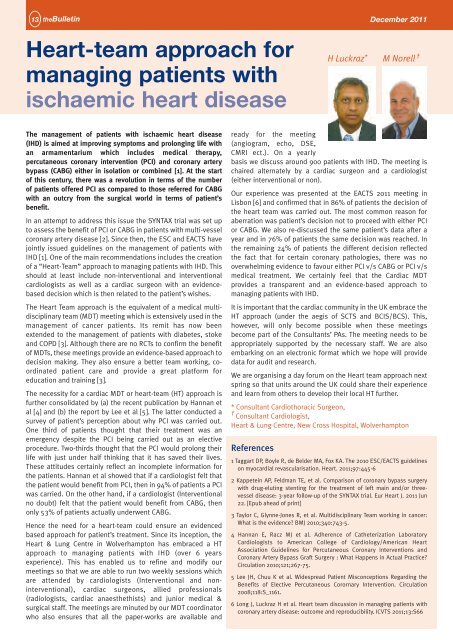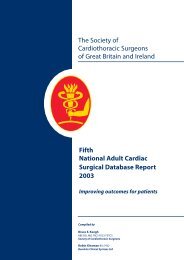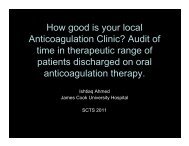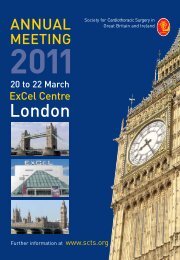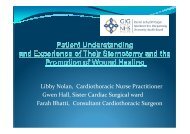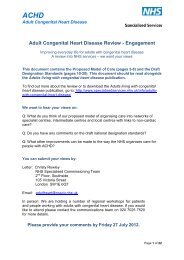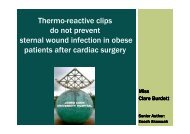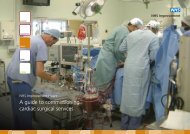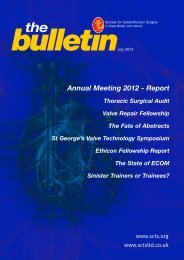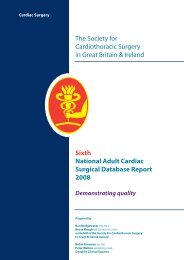Download - Society for Cardiothoracic Surgery
Download - Society for Cardiothoracic Surgery
Download - Society for Cardiothoracic Surgery
Create successful ePaper yourself
Turn your PDF publications into a flip-book with our unique Google optimized e-Paper software.
13 theBulletin<br />
December 2011<br />
Heart-team approach <strong>for</strong><br />
managing patients with<br />
ischaemic heart disease<br />
H Luckraz * M Norell †<br />
The management of patients with ischaemic heart disease<br />
(IHD) is aimed at improving symptoms and prolonging life with<br />
an armamentarium which includes medical therapy,<br />
percutaneous coronary intervention (PCI) and coronary artery<br />
bypass (CABG) either in isolation or combined [1]. At the start<br />
of this century, there was a revolution in terms of the number<br />
of patients offered PCI as compared to those referred <strong>for</strong> CABG<br />
with an outcry from the surgical world in terms of patient’s<br />
benefit.<br />
In an attempt to address this issue the SYNTAX trial was set up<br />
to assess the benefit of PCI or CABG in patients with multi-vessel<br />
coronary artery disease [2]. Since then, the ESC and EACTS have<br />
jointly issued guidelines on the management of patients with<br />
IHD [1]. One of the main recommendations includes the creation<br />
of a “Heart-Team” approach to managing patients with IHD. This<br />
should at least include non-interventional and interventional<br />
cardiologists as well as a cardiac surgeon with an evidencebased<br />
decision which is then related to the patient’s wishes.<br />
The Heart Team approach is the equivalent of a medical multidisciplinary<br />
team (MDT) meeting which is extensively used in the<br />
management of cancer patients. Its remit has now been<br />
extended to the management of patients with diabetes, stoke<br />
and COPD [3]. Although there are no RCTs to confirm the benefit<br />
of MDTs, these meetings provide an evidence-based approach to<br />
decision making. They also ensure a better team working, coordinated<br />
patient care and provide a great plat<strong>for</strong>m <strong>for</strong><br />
education and training [3].<br />
The necessity <strong>for</strong> a cardiac MDT or heart-team (HT) approach is<br />
further consolidated by (a) the recent publication by Hannan et<br />
al [4] and (b) the report by Lee et al [5]. The latter conducted a<br />
survey of patient’s perception about why PCI was carried out.<br />
One third of patients thought that their treatment was an<br />
emergency despite the PCI being carried out as an elective<br />
procedure. Two-thirds thought that the PCI would prolong their<br />
life with just under half thinking that it has saved their lives.<br />
These attitudes certainly reflect an incomplete in<strong>for</strong>mation <strong>for</strong><br />
the patients. Hannan et al showed that if a cardiologist felt that<br />
the patient would benefit from PCI, then in 94% of patients a PCI<br />
was carried. On the other hand, if a cardiologist (Interventional<br />
no doubt) felt that the patient would benefit from CABG, then<br />
only 53% of patients actually underwent CABG.<br />
Hence the need <strong>for</strong> a heart-team could ensure an evidenced<br />
based approach <strong>for</strong> patient’s treatment. Since its inception, the<br />
Heart & Lung Centre in Wolverhampton has embraced a HT<br />
approach to managing patients with IHD (over 6 years<br />
experience). This has enabled us to refine and modify our<br />
meetings so that we are able to run two weekly sessions which<br />
are attended by cardiologists (Interventional and noninterventional),<br />
cardiac surgeons, allied professionals<br />
(radiologists, cardiac anaesthethists) and junior medical &<br />
surgical staff. The meetings are minuted by our MDT coordinator<br />
who also ensures that all the paper-works are available and<br />
ready <strong>for</strong> the meeting<br />
(angiogram, echo, DSE,<br />
CMRI ect.). On a yearly<br />
basis we discuss around 900 patients with IHD. The meeting is<br />
chaired alternately by a cardiac surgeon and a cardiologist<br />
(either interventional or non).<br />
Our experience was presented at the EACTS 2011 meeting in<br />
Lisbon [6] and confirmed that in 86% of patients the decision of<br />
the heart team was carried out. The most common reason <strong>for</strong><br />
aberration was patient’s decision not to proceed with either PCI<br />
or CABG. We also re-discussed the same patient’s data after a<br />
year and in 76% of patients the same decision was reached. In<br />
the remaining 24% of patients the different decision reflected<br />
the fact that <strong>for</strong> certain coronary pathologies, there was no<br />
overwhelming evidence to favour either PCI v/s CABG or PCI v/s<br />
medical treatment. We certainly feel that the Cardiac MDT<br />
provides a transparent and an evidence-based approach to<br />
managing patients with IHD.<br />
It is important that the cardiac community in the UK embrace the<br />
HT approach (under the aegis of SCTS and BCIS/BCS). This,<br />
however, will only become possible when these meetings<br />
become part of the Consultants’ PAs. The meeting needs to be<br />
appropriately supported by the necessary staff. We are also<br />
embarking on an electronic <strong>for</strong>mat which we hope will provide<br />
data <strong>for</strong> audit and research.<br />
We are organising a day <strong>for</strong>um on the Heart team approach next<br />
spring so that units around the UK could share their experience<br />
and learn from others to develop their local HT further.<br />
* Consultant <strong>Cardiothoracic</strong> Surgeon,<br />
† Consultant Cardiologist,<br />
Heart & Lung Centre, New Cross Hospital, Wolverhampton<br />
References<br />
1 Taggart DP, Boyle R, de Belder MA, Fox KA. The 2010 ESC/EACTS guidelines<br />
on myocardial revascularisation. Heart. 2011;97:445-6<br />
2 Kappetein AP, Feldman TE, et al. Comparison of coronary bypass surgery<br />
with drug-eluting stenting <strong>for</strong> the treatment of left main and/or threevessel<br />
disease: 3-year follow-up of the SYNTAX trial. Eur Heart J. 2011 Jun<br />
22. [Epub ahead of print]<br />
3 Taylor C, Glynne-Jones R, et al. Multidisciplinary Team working in cancer:<br />
What is the evidence? BMJ 2010;340:743-5.<br />
4 Hannan E, Racz MJ et al. Adherence of Catheterization Laboratory<br />
Cardiologists to American College of Cardiology/American Heart<br />
Association Guidelines <strong>for</strong> Percutaneous Coronary Interventions and<br />
Coronary Artery Bypass Graft <strong>Surgery</strong> : What Happens in Actual Practice?<br />
Circulation 2010;121;267-75.<br />
5 Lee JH, Chuu K et al. Widespread Patient Misconceptions Regarding the<br />
Benefits of Elective Percutaneous Corornary Intervention. Circulation<br />
2008;118:S_1161.<br />
6 Long J, Luckraz H et al. Heart team discussion in managing patients with<br />
coronary artery disease: outcome and reproducibility. ICVTS 2011;13:S66


